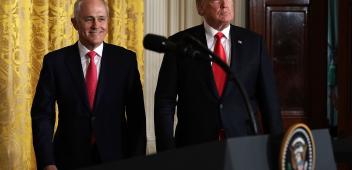Yes, we can spend our way to recovery if we are careful
Australia has rightly lost its fear of big deficits. But we must walk back debt in lockstep with private sector expansion. Originally published in The Australian Financial Review.

COVID-19 transformed federal budget policy miraculously. Canberra had been rigorously on-course to satisfy the long-standing bipartisan objective of budget surplus. However, as soon as the enormity of the virus was apparent, a deficit of nearly 10 per cent of GDP – one of the highest in the world – was implemented, with universal approval.
Miraculous though this is, the next stage requires even greater policy dexterity: getting the budget back to normal. But the COVID-19 experience has upended what normality might be.
While there are still true believers in the intrinsic virtue of budget surpluses, the pandemic experience has changed many perceptions. It has shown just how successful fiscal expansion can be, with earlier gloomy forecasts quickly upgraded, thanks to this bold stimulus.
Fears that fiscal expenditure was intrinsically slow to respond have been falsified. Concerns that government debt would reach an unstable tipping point have lost credibility. Credit rating agencies are less intimidating after their pathetic performance in the 2008 crisis. Moralising about burdening future generations with debt seems over-egged, given the substantial public assets they will inherit.
Unconventional monetary policy – first in the US, then more recently in Australia – has altered debt-burden calculations, with Australia’s budget interest costs below 1 per cent of GDP – less than before the coronavirus struck. The bond vigilantes have gone quiet. There is widespread acceptance that budget deficits can be funded easily, and at little cost.
At the same time, there is universal agreement that our current deficit, close to 10 per cent of GDP, is not sustainable. There is a fair bit of agreement that expenditures targeted at COVID-19 damage should be wound back and targeted more precisely. When opportunity presents, the ‘fiscal cannon’ should be reloaded.
The current plan to wind back the deficit by more than 5 per cent of GDP over the next year implies a powerful contractionary element. If the budget multiplier is one (a conservative guess), this cut-back takes 5 per cent off next year’s growth. The hope is that this will be offset by the public’s running down of the substantial savings balances built up during the pandemic lockdowns.
Fiscal policy has demonstrated its stimulatory power: it is just as powerful in contractionary mode.
Winding back the deficit faster than the private expenditure is expanding would mean a limp recovery. Fiscal policy has demonstrated its stimulatory power: it is just as powerful in contractionary mode.
A quick return to strong growth is now vital, not only for unemployment and inflation objectives, but for debt management as well. If nominal GDP is growing significantly faster than the interest rate on public debt – as it is at present – a modest deficit is consistent with a stable debt ratio.
Take the example of the high debt ratio following WWII. This ratio was run down over time, not by budget surpluses and repayments, but by strong growth in nominal GDP.
If we now try too hard to get the deficit down quickly, driven by the false objective of budget surplus, we won’t get the growth needed to make this beneficial arithmetic work. The best path will be one that relies on strong growth to bring the deficit and the debt ratio down over time.
Sustaining the necessary good pace of growth might present the greatest challenge.
Sure, we’re coming out of the virus-induced downturn well. However, a return to the pre-COVID-19 norm isn’t good enough. The recovery from the 2008 global financial crisis was feeble, with zero growth in per capita disposable income between 2013 and 2019. A decade after the crisis, unemployment was still over 5 percent. Much of this flaccid recovery can be explained by the effort to get the budget back into surplus.
As well, the private sector seemed to have lost its mojo – business investment ran at 9 per cent of GDP rather than its pre-2008 norm of 12 per cent, despite historically low borrowing costs. It looks like Australia might have some of the ‘secular stagnation’ syndrome identified in the United States. Business risk aversion is likely to remain high in the period following COVID-19.
The current American response is worth noting. Not only did President Joe Biden implement by far the largest COVID-19 budget stimulus among major countries, but he has now announced a longer-term plan for major infrastructure expenditure. Starting with debt levels double Australia’s, the US is prioritising growth, driven by debt-funded public infrastructure spending.
The arguments against this are well-known. Without the discipline of the market, we can end up with more Alice Springs-to-Darwin railways and home-made submarine projects. That said, perhaps we might take some comfort from Australia’s competent handling of COVID-19. The same reliance on evidence-based expert advice can avoid the pitfalls.
The post-COVID-19 challenge can’t be addressed by a rigid budget surplus objective driven by small-government ideology. The key to success is policy flexibility, keeping the deficit reduction in lock-step with the private sector recovery. Monetary policy, already distorting asset prices through near-zero interest rates, can’t be the balancing item, offsetting an overly contractionary budget.



